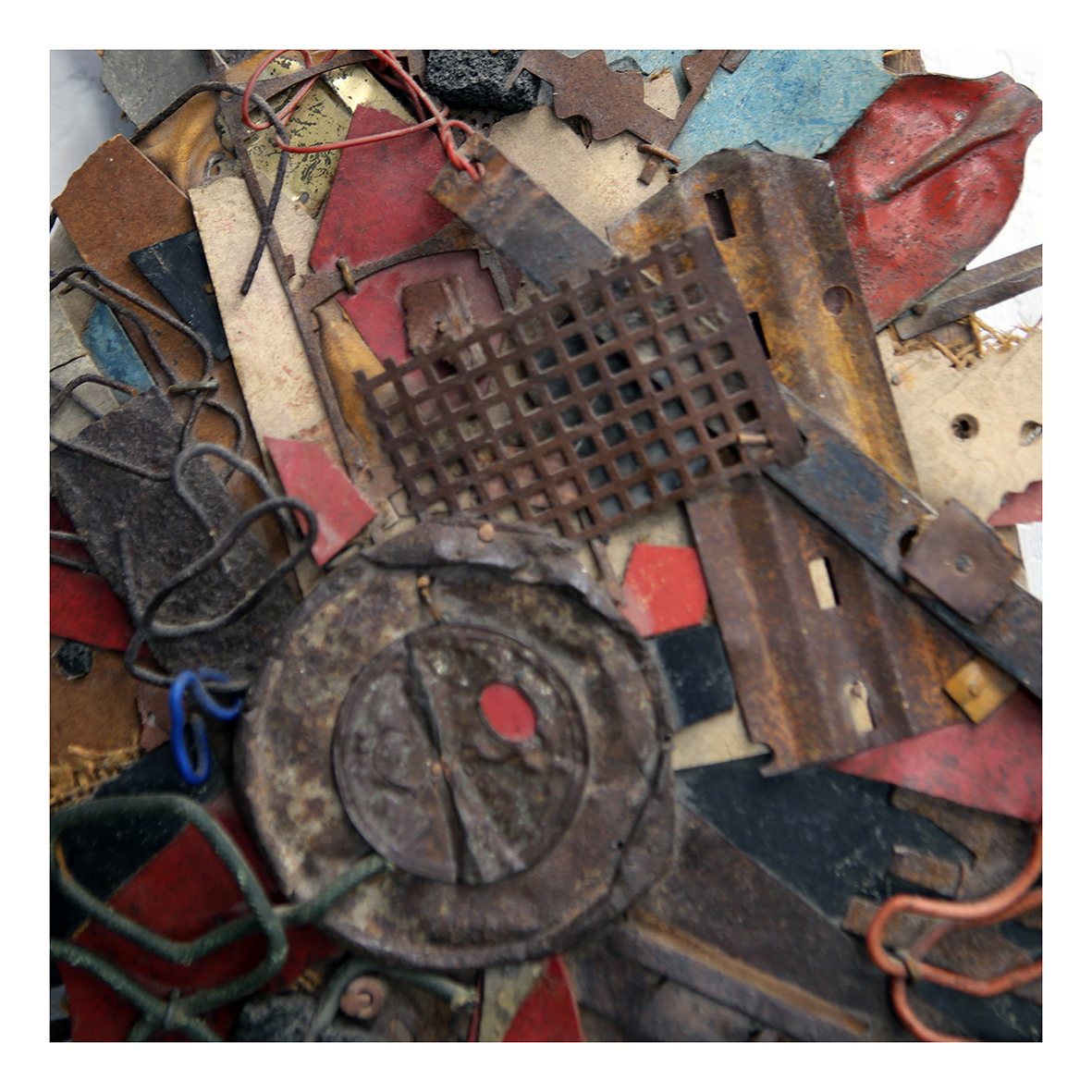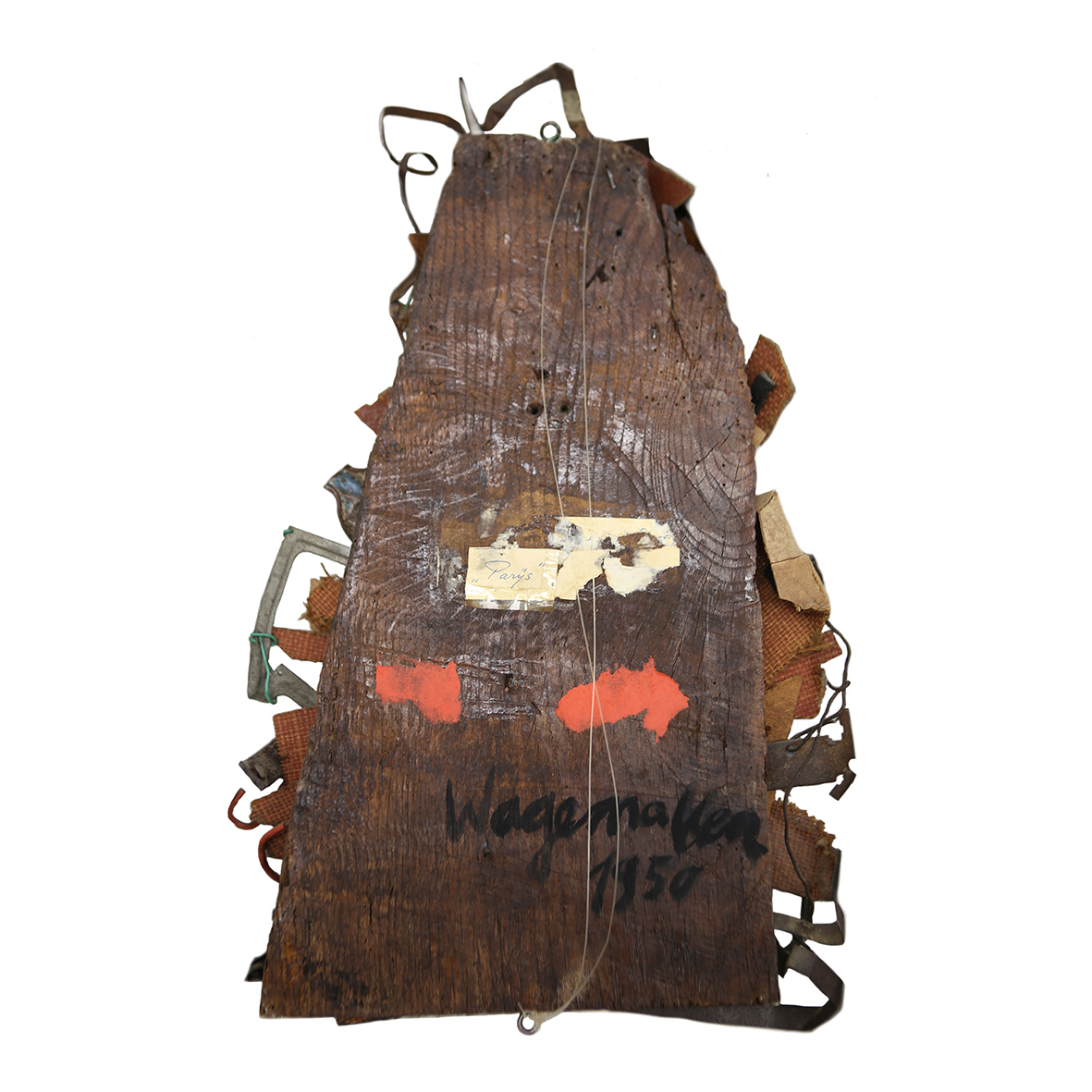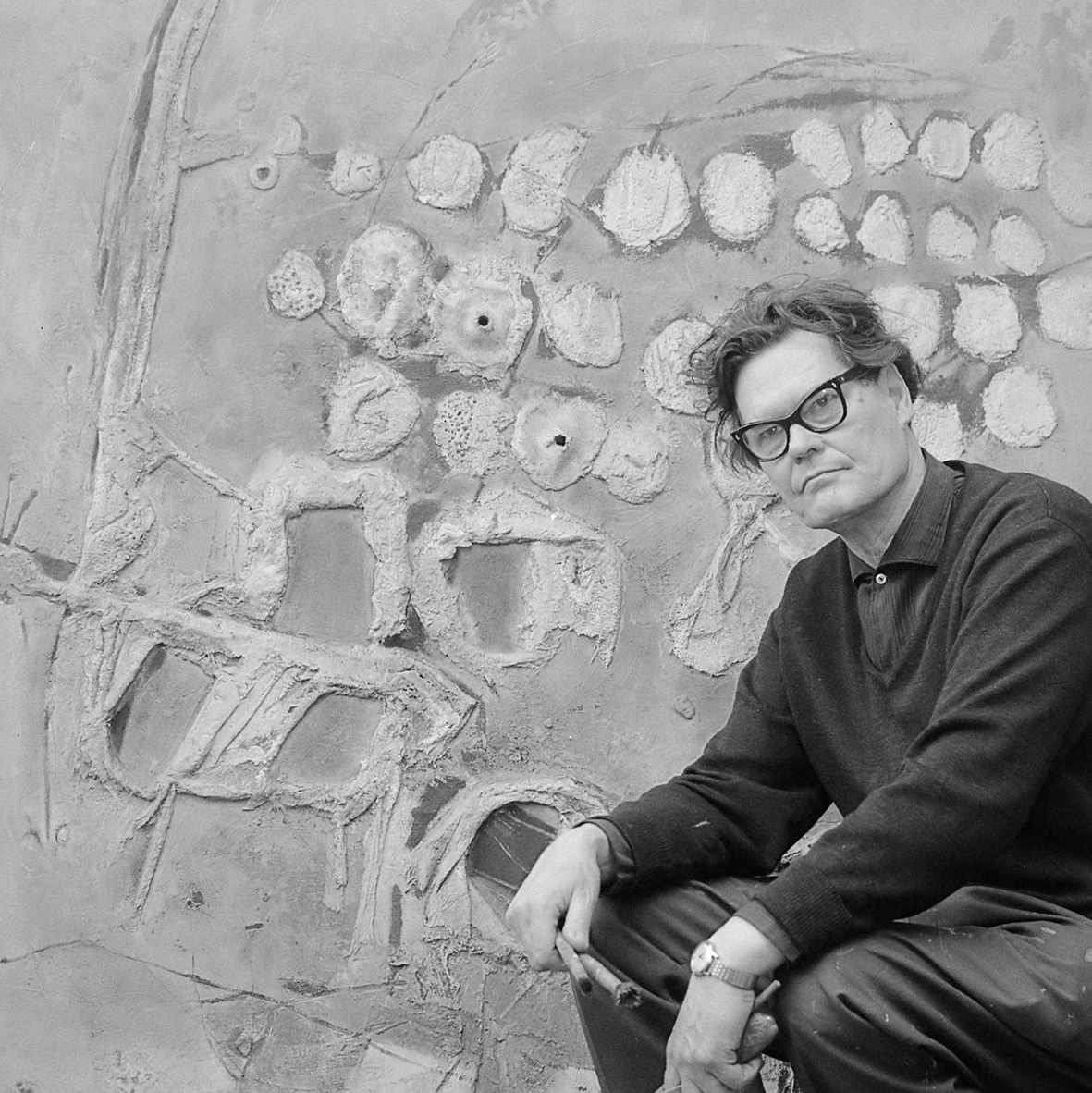CATEGORY: ART
Early work by the important Dutch material artist Jaap Wagemaker. Titled "Paris", a graphical representation of the Moulin Rouge. This museum object is made of materials found in the streets of Paris, such as wood, electricity wire and metals. During the World War, Wagemaker was not allowed to purchase materials, so the fact that he used working with found objects makes this piece extra relevant in his total oeuvre.
Creator:
Jaap Wagemaker (1906-1972 Haarlem, The Netherlands)
Object:
Matter Art • Sculpture • Object • Assembly
Country:
The Netherlands
Design period:
1950
Production period:
1950
Identifying marks:
Signed, titled "Parijs" and dated "1950" on verso.
Style:
Matterism • modernism • abstract
Condition:
In very good, unrestored condition.
Material:
Wood, metal, wire, electrical cables, vilt and others
Colour:
Various
Dimensions:
Board W 35.0 x H 52.0 x D 6.0 cm
Biography
Jaap Wagemaker (Haarlem, 6 January 1906 – 28 January 1972) was a Dutch painter and one of the first matter painters (in Dutch: materieschilders) in the Netherlands. He was born as the son of a saddler/upholsterer in the center of Haarlem. Due to a lack of his left hip, he became limp at a young age. As a result, he stayed home a lot from school and drew a lot. At the age of 14 he went to the School of Architecture, Decorative Arts and Craftsmanship in Haarlem, where he studied Decorative Arts. Here the foundation was laid for his later thorough knowledge of all kinds of materials. He received lessons from the sculptor Jan Bronner. In addition, the then director taught philosophy, Eastern religions and art history. Later on, Jaap Wagemaker would develop an extensive interest in the rites and symbols of ethnic peoples. Although he excelled in drawing during his training, he preferred to focus on painting. However, this was not given in Haarlem. Since he did not receive a scholarship for the Rijksakademie in Amsterdam, he remained a self-taught artist.
Not able to purchase materials
Wagemaker initially painted the visible world, albeit in an expressionist style, in which the influence of the Belgian expressionist Constant Permeke was clearly apparent, later it was the more poetic Herman Kruyder who gained influence on his work. Around 1930 Wagemaker lived for a while in Paris and worked together with the painter Piet van Egmond. At that time, he began to collect ethnographics at the flea markets there. During the war years 1940 -1945 he refused to become a member of the Kultuurkamer established by the Germans and could therefore not purchase any material or exhibit in those years. He married and moved to Bilthoven.
The Parisian years after 1945
After the war, Wagemaker moved to Amsterdam and got a studio there in the complex on Zomerdijkstraat. In terms of style, like so many other artists in those years, he was influenced by Picasso. He was then fascinated by Cobra via Anton Rooskens and Corneille, but discovered in the process that his way of expressing himself could not be found there. In addition, he considered himself too old to join Cobra. After a divorce and a second marriage, he moved to Paris in 1952 with his wife Didi van der Meer. Here he fell under the spell of the work of Jean Dubuffet, Fautrier, Wols and the other matter painters. The work of the Italian Alberto Burri, who often built his artworks from jute and plaster, and the Spanish painter Antoni Tàpies with his 'wall' paintings also had a great influence on Wagemaker and remained a source of inspiration for him for a long time. Back in the Netherlands, there was still no interest in this matter art, of which Wagemaker had become a part with his work while working. In 1958 he returned to Paris and worked for a while in the studio of Kees van Bohemen in the Rue Santeuil, where several artists of the Cobra also worked. Here he got to know the Flemish material painter Bram Bogart.
The later work
From 1960, Wagemaker's typical matter art began to emerge: abstract assemblages, the relief of which was built up in large, sturdy forms with all kinds of parts, pipes and dishes and other materials. In these robust material paintings found steel parts, jute cloths, plaster, slate, pieces of wood, but also shells were put together into a very close and cohesive composition. The color schemes of his assemblages are often earthy colours, with the occasional exception. Some of these works are strongly reminiscent of views seen from an airplane, of villages and hamlets in Africa or Asia. The construction of his assemblies is very solid and highly finished, in contrast to the practice of other matter artists, especially from France.
Recognition
Wagemaker's work did not appeal very much to the French public of 1950 at the time. He did get success in Germany after a tip from Anton Rooskens; his work caught on there and was bought there. He also became acquainted with the German matter painters of those years, Wim Schuhmacher and Dahmen. From 1955, the recognition for his work in the Netherlands grew. He exhibited regularly at the Stedelijk Museum in Amsterdam, such as with solo exhibitions in 1957 and 1967, and at the Gemeentemuseum in The Hague in 1965. His work was presented in America by Willem Sandberg, among others, and in 1962 he took part in the Dutch art submission for the Venice Biennale. In 1966 he received the gold medal of the Florence Biennale.
Travels
Wagemaker later made many trips to, among others, the Dogon in Africa in 1963, Yugoslavia, Greece, Turkey in 1967, Egypt, Israel, Morocco, Russia in 1968 and Mexico. These travels provided him with much inspiration for his work; the titles of his works also refer to this.
Friends and colleagues
Wagemaker had intensive contact with, among others, Wim de Haan, Anton Rooskens, Joop Moesman and Wim Strijbos in the 1950s. He later also had contact with Theo Bennes and Gerard Verdijk.
Matter painting
Material painting is an art movement from informal painting that arose at the end of the 1950s. The artist who uses this style is called a matter painter. This movement developed internationally with the aim of bridging the gap between traditional painting and spatial sculpture. Characteristic of matter painting is the relief-like surface and the complex texture of the canvas, created by adding less obvious materials to the thick layers of paint, such as sand, plaster, jute, straw, etc. In doing so, the canvas is left intact as a carrier. The combination of paint with these alternative elements can increase the expressiveness, can pursue aesthetic goals or refer to primitive art such as the rock paintings. Important figures for this painting style are: Jean Dubuffet, Jean Fautrier, Alberto Burri, Antoni Tàpies, Bram Bogart, Jaap Wagemaker and E. Schumacher. From: Albert Van Wiemeersch, International Lexicon of the modern visual arts, Kunstforum Schelderode, 1988.
Early work by the important Dutch material artist Jaap Wagemaker. Titled "Paris", a graphical representation of the Moulin Rouge. This museum object is made of materials found in the streets of Paris, such as wood, electricity wire and metals. During the World War, Wagemaker was not allowed to purchase materials, so the fact that he used working with found objects makes this piece extra relevant in his total oeuvre.
Creator:
Jaap Wagemaker (1906-1972 Haarlem, The Netherlands)
Object:
Matter Art • Sculpture • Object • Assembly
Country:
The Netherlands
Design period:
1950
Production period:
1950
Identifying marks:
Signed, titled "Parijs" and dated "1950" on verso.
Style:
Matterism • modernism • abstract
Condition:
In very good, unrestored condition.
Material:
Wood, metal, wire, electrical cables, vilt and others
Colour:
Various
Dimensions:
Board W 35.0 x H 52.0 x D 6.0 cm
Biography
Jaap Wagemaker (Haarlem, 6 January 1906 – 28 January 1972) was a Dutch painter and one of the first matter painters (in Dutch: materieschilders) in the Netherlands. He was born as the son of a saddler/upholsterer in the center of Haarlem. Due to a lack of his left hip, he became limp at a young age. As a result, he stayed home a lot from school and drew a lot. At the age of 14 he went to the School of Architecture, Decorative Arts and Craftsmanship in Haarlem, where he studied Decorative Arts. Here the foundation was laid for his later thorough knowledge of all kinds of materials. He received lessons from the sculptor Jan Bronner. In addition, the then director taught philosophy, Eastern religions and art history. Later on, Jaap Wagemaker would develop an extensive interest in the rites and symbols of ethnic peoples. Although he excelled in drawing during his training, he preferred to focus on painting. However, this was not given in Haarlem. Since he did not receive a scholarship for the Rijksakademie in Amsterdam, he remained a self-taught artist.
Not able to purchase materials
Wagemaker initially painted the visible world, albeit in an expressionist style, in which the influence of the Belgian expressionist Constant Permeke was clearly apparent, later it was the more poetic Herman Kruyder who gained influence on his work. Around 1930 Wagemaker lived for a while in Paris and worked together with the painter Piet van Egmond. At that time, he began to collect ethnographics at the flea markets there. During the war years 1940 -1945 he refused to become a member of the Kultuurkamer established by the Germans and could therefore not purchase any material or exhibit in those years. He married and moved to Bilthoven.
The Parisian years after 1945
After the war, Wagemaker moved to Amsterdam and got a studio there in the complex on Zomerdijkstraat. In terms of style, like so many other artists in those years, he was influenced by Picasso. He was then fascinated by Cobra via Anton Rooskens and Corneille, but discovered in the process that his way of expressing himself could not be found there. In addition, he considered himself too old to join Cobra. After a divorce and a second marriage, he moved to Paris in 1952 with his wife Didi van der Meer. Here he fell under the spell of the work of Jean Dubuffet, Fautrier, Wols and the other matter painters. The work of the Italian Alberto Burri, who often built his artworks from jute and plaster, and the Spanish painter Antoni Tàpies with his 'wall' paintings also had a great influence on Wagemaker and remained a source of inspiration for him for a long time. Back in the Netherlands, there was still no interest in this matter art, of which Wagemaker had become a part with his work while working. In 1958 he returned to Paris and worked for a while in the studio of Kees van Bohemen in the Rue Santeuil, where several artists of the Cobra also worked. Here he got to know the Flemish material painter Bram Bogart.
The later work
From 1960, Wagemaker's typical matter art began to emerge: abstract assemblages, the relief of which was built up in large, sturdy forms with all kinds of parts, pipes and dishes and other materials. In these robust material paintings found steel parts, jute cloths, plaster, slate, pieces of wood, but also shells were put together into a very close and cohesive composition. The color schemes of his assemblages are often earthy colours, with the occasional exception. Some of these works are strongly reminiscent of views seen from an airplane, of villages and hamlets in Africa or Asia. The construction of his assemblies is very solid and highly finished, in contrast to the practice of other matter artists, especially from France.
Recognition
Wagemaker's work did not appeal very much to the French public of 1950 at the time. He did get success in Germany after a tip from Anton Rooskens; his work caught on there and was bought there. He also became acquainted with the German matter painters of those years, Wim Schuhmacher and Dahmen. From 1955, the recognition for his work in the Netherlands grew. He exhibited regularly at the Stedelijk Museum in Amsterdam, such as with solo exhibitions in 1957 and 1967, and at the Gemeentemuseum in The Hague in 1965. His work was presented in America by Willem Sandberg, among others, and in 1962 he took part in the Dutch art submission for the Venice Biennale. In 1966 he received the gold medal of the Florence Biennale.
Travels
Wagemaker later made many trips to, among others, the Dogon in Africa in 1963, Yugoslavia, Greece, Turkey in 1967, Egypt, Israel, Morocco, Russia in 1968 and Mexico. These travels provided him with much inspiration for his work; the titles of his works also refer to this.
Friends and colleagues
Wagemaker had intensive contact with, among others, Wim de Haan, Anton Rooskens, Joop Moesman and Wim Strijbos in the 1950s. He later also had contact with Theo Bennes and Gerard Verdijk.
Matter painting
Material painting is an art movement from informal painting that arose at the end of the 1950s. The artist who uses this style is called a matter painter. This movement developed internationally with the aim of bridging the gap between traditional painting and spatial sculpture. Characteristic of matter painting is the relief-like surface and the complex texture of the canvas, created by adding less obvious materials to the thick layers of paint, such as sand, plaster, jute, straw, etc. In doing so, the canvas is left intact as a carrier. The combination of paint with these alternative elements can increase the expressiveness, can pursue aesthetic goals or refer to primitive art such as the rock paintings. Important figures for this painting style are: Jean Dubuffet, Jean Fautrier, Alberto Burri, Antoni Tàpies, Bram Bogart, Jaap Wagemaker and E. Schumacher. From: Albert Van Wiemeersch, International Lexicon of the modern visual arts, Kunstforum Schelderode, 1988.
JAAP WAGEMAKER
(1906-1972)
Matter Art, assembly object
Moulin Rouge, Paris
1950
(1906-1972)
Matter Art, assembly object
Moulin Rouge, Paris
1950

Price on request






